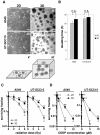Genome-wide gene expression analysis in cancer cells reveals 3D growth to affect ECM and processes associated with cell adhesion but not DNA repair
- PMID: 22509286
- PMCID: PMC3324525
- DOI: 10.1371/journal.pone.0034279
Genome-wide gene expression analysis in cancer cells reveals 3D growth to affect ECM and processes associated with cell adhesion but not DNA repair
Abstract
Cell morphology determines cell behavior, signal transduction, protein-protein interaction, and responsiveness to external stimuli. In cancer, these functions profoundly contribute to resistance mechanisms to radio- and chemotherapy. With regard to this aspect, this study compared the genome wide gene expression in exponentially growing cell lines from different tumor entities, lung carcinoma and squamous cell carcinoma, under more physiological three-dimensional (3D) versus monolayer cell culture conditions. Whole genome cDNA microarray analysis was accomplished using the Affymetrix HG U133 Plus 2.0 gene chip. Significance analysis of microarray (SAM) and t-test analysis revealed significant changes in gene expression profiles of 3D relative to 2D cell culture conditions. These changes affected the extracellular matrix and were mainly associated with biological processes like tissue development, cell adhesion, immune system and defense response in contrast to terms related to DNA repair, which lacked significant alterations. Selected genes were verified by semi-quantitative RT-PCR and Western blotting. Additionally, we show that 3D growth mediates a significant increase in tumor cell radio- and chemoresistance relative to 2D. Our findings show significant gene expression differences between 3D and 2D cell culture systems and indicate that cellular responsiveness to external stress such as ionizing radiation and chemotherapeutics is essentially influenced by differential expression of genes involved in the regulation of integrin signaling, cell shape and cell-cell contact.
Conflict of interest statement
Figures





References
-
- Smalley KS, Lioni M, Herlyn M. Life isn't flat: taking cancer biology to the next dimension. In Vitro Cell Dev Biol Anim. 2006;42:242–247. - PubMed
Publication types
MeSH terms
LinkOut - more resources
Full Text Sources
Other Literature Sources
Molecular Biology Databases

